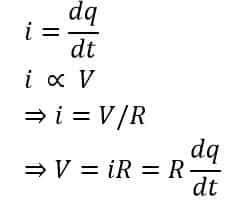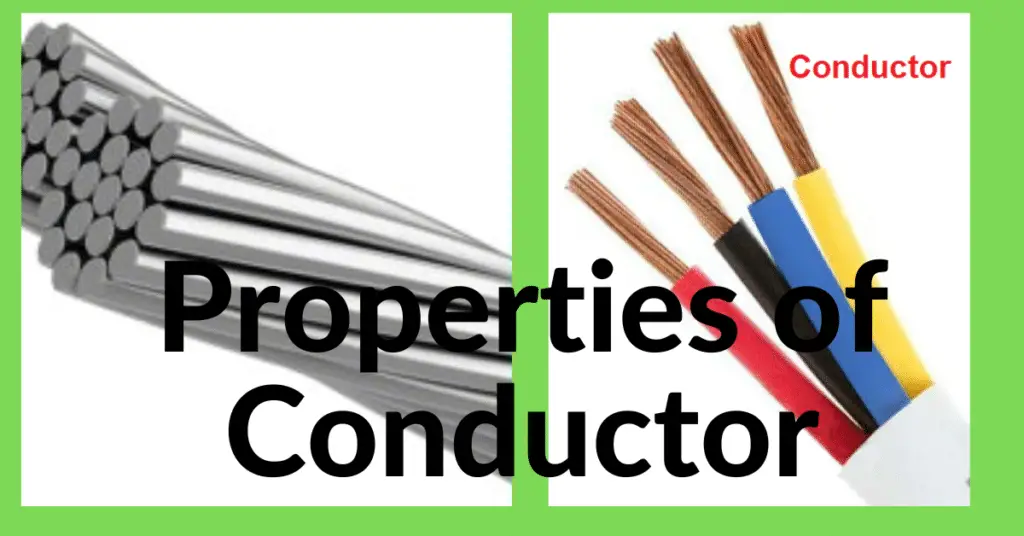This article describes the properties of electrical conductor, such as conductivity, resistivity, thermal conductivity, malleability, ductility, and reflectivity.
What is an Electrical Conductor?
An electrical conductor is a path or medium through which electrical charges flow from one point to another to perform work. Electrical charges exert attractive or repulsive forces on each other, depending on their nature.
How Does a Conductor Help in Doing Work?
To convert electrical energy into another form of energy (like heat or mechanical energy), charges must move under the influence of an electric field. A conductor allows this movement, enabling work to be done since work is the product of force and displacement.

Examples of Conducting Materials
Electrical conductors are usually made from good conducting materials such as copper, nichrome, and aluminum. The choice of conductor depends on the application and required properties.
Conductors, Semiconductors, and Insulators
- Conductors: Allow free flow of electric charges.
- Semiconductors: Act as a conductor or insulator depending on external conditions, useful in high-frequency switching applications.
- Insulators: Do not conduct electricity freely under normal voltages. They are used for covering conductors and ensuring safe handling.
Electric Current in a Conductor
The flow of charge through a conductor per unit time is known as electric current. In simple terms, it is the number of charged particles moving through a conductor in one second.
According to Ohm’s Law, this electric current is directly proportional to the potential difference across the conductor. Current always flows from a higher potential to a lower potential.

Where:
- V = Potential difference across the conductor
- I = Electric current
- q = Charge
- t = Time
- R = Resistance of the conductor (constant of proportionality)
Now that we understand what a conductor is and how it works, let’s look at the various properties of conductors that determine their selection for practical applications.
Read detailed article: Electric Current – Definition, Symbol, Formula & Theory
Properties of Electrical Conductors
Below are the 9 important properties of electrical conductors, explained in detail.
- Conductivity
- Resistivity
- Availability of free electrons
- Thermal conductivity
- Ductility
- Malleability
- Inductance
- Electric Field Inside Conductor zero
- Reflectivity
1. Conductivity- Property of conductor
The conductivity of a conductor is one of the most important factors when comparing two or more conductors based on their efficiency.
As the name suggests, conductivity measures the ease of flow of electric current through a conductor for a given potential difference. This property allows us to differentiate between a conductor, a semiconductor, and an insulator.
All metals, such as copper, aluminum, and silver, are good conductors of electricity. Among them, copper and aluminum are extensively used in electrical machines and appliances because they are cost-effective and have high conductivity.
Conductivity (σ) is denoted by the Greek letter σ and is the reciprocal of resistivity. It is calculated using the formula:

Where:
- R = Resistance of the conductor
- l = Length of the conductor
- A = Cross-sectional area of the conductor
The conductivity can also be represented as:

Where S=1/R and S are known as conductance. The unit of conductance is Siemens.
Where:
- S=1/R and S is known as conductance.
- The unit of conductance is Siemens (S).
Thus, conductivity is the property of a conductor that enables it to easily allow the flow of electric current.
2. Resistivity
Resistivity (ρ) is the reciprocal of conductivity (σ). It measures the hindrance or opposition to the flow of electric current through a conductor. Naturally, a good conductor must have low resistivity.
The resistivity of a conductor is calculated using the formula:

Where:
- R = Resistance of the conductor
- l = Length of the conductor
- A = Cross-sectional area of the conductor
In contrast to conductivity, resistivity is the property that resists the flow of electric current.
3. Availability of Free Electrons
The presence of free electrons is a crucial property of a conductor, as it allows electric current to flow through a material.
In metals, electrons in the outer shell are loosely bound to the nucleus. When an electric field is applied (due to a potential difference), these electrons are freed from their atoms, creating a pool of free electrons that can move throughout the metal. Since electrons carry a negative charge, their movement enables the conduction of electric current.
In contrast, non-conductors or insulators have no free electrons in their outer shell. To make them conduct, a strong electric field is required to extract electrons, which only occurs at very high voltages known as the breakdown voltage.
For example, the breakdown strength of air is 30 kV/cm. This means electricity can jump across a 1 cm air gap if the potential difference reaches 30 kV or more. Until this voltage is reached, the air acts as a safe insulator, preventing current flow between the two points.
4. Thermal Conductivity- Property of Conductor
Thermal conductivity is as important for a conductor as electrical conductivity. When an electrical machine or appliance runs continuously, the flow of current through the conductor generates heat due to its intrinsic resistance. This heat represents a loss of input power that cannot be completely eliminated.
Therefore, a good conductor must have a high melting point and be capable of handling increased temperatures. Metals like copper and aluminum have high thermal conductivity, which is why they are commonly used in heavy-duty electrical machines.
The heat generated in a conductor is calculated using the formula:

Where:
- I = Current through the conductor
- R = Resistance of the conductor
- t = Time for which the current flows
From this equation, it is clear that to reduce heat loss, one must decrease either the current (I), resistance (R), or time of operation (t). In practical applications, I and t cannot be reduced beyond a certain limit. Therefore, a low-resistance conductor is essential to efficiently handle the heat generated.
5. Ductility
Many conductors, such as copper and aluminum, are highly ductile, meaning they can be drawn into thin wires without breaking.
This property is crucial for the production of electrical wires and cables, as it allows conductors to be shaped into long, flexible forms while maintaining their electrical conductivity and mechanical strength.
6. Malleability- Property of Conductor
A conducting material must be malleable, meaning it can be easily shaped or formed into different configurations without breaking.
This property is particularly useful for applications such as creating conductive tracks on circuit boards and forming various electrical components, where precise shaping of the conductor is required.
7. Inductance
Inductance is the tendency of an electrical conductor to oppose changes in the electric current flowing through it.
For a conductor carrying direct current (DC), inductance is usually not a problem because the current is constant and its rate of change is zero. However, most practical appliances and machines operate on alternating current (AC), making inductance an important factor.
According to the laws of electromagnetic induction, a time-varying current passing through a conductor generates a magnetic flux both inside and around the conductor. The magnetic field outside the conductor is much weaker than the field inside.
This magnetic field induces an electromotive force (emf) within the conductor that opposes the applied voltage. The induced emf is calculated using the formula:

Where:
- E = Induced emf
- L = Inductance of the conductor
- di/dt = Rate of change of current
The negative (-) sign in the formula indicates that the induced emf opposes the applied voltage across the conductor, following Lenz’s Law.
This induced emf reduces the current flowing through the conductor, forcing the current to move along paths where the magnetic field effect is lower, mainly along the outer surface of the conductor. This phenomenon is called the skin effect.
The skin effect reduces the effective cross-sectional area of the conductor, as current tends to flow along the surface rather than through the core, leading to inefficiencies.
From the above equation, it is clear that the inductance (L) of a good conductor should be low to minimize skin effect and ensure efficient current flow.
8. Electric Field Inside a Conductor is Zero
A conductor naturally has no internal electric field. This property allows electrons to move freely within the conductor.
If there were an internal electric field, the electrons would align opposite to the field, creating pools of negative and positive charges separated inside the conductor.
However, in a normal conductor, electrons move freely until an external electric field is applied, at which point they respond to the imposed voltage.
9. Reflectivity
When electromagnetic waves, including light, fall on the surface of a good conductor, they are reflected.
Metals like silver and copper are excellent conductors because they have free electrons that can move easily when exposed to electromagnetic waves.
The back-and-forth movement of these electrons sets up an oscillating electric current within the conductor. This current, in turn, generates electromagnetic waves known as the reflected waves.
Quick Summary: Properties of Electrical Conductors
| Property | Description | Example / Importance |
| Conductivity | Ability to allow easy flow of electric current; reciprocal of resistivity. | Copper, Aluminum → widely used in wires. |
| Resistivity | Opposition to current flow; reciprocal of conductivity. | Low resistivity = better conductor. |
| Free Electrons | Presence of loosely bound electrons enables current flow. | Metals have free electrons; insulators don’t. |
| Thermal Conductivity | Ability to transfer heat efficiently. | Copper, Aluminum handle heating in machines. |
| Ductility | Can be drawn into thin wires without breaking. | Essential for making electrical wires. |
| Malleability | Can be shaped into different forms without breaking. | Used in PCB tracks and components. |
| Inductance | Tendency to oppose change in current due to induced emf. | Low inductance reduces skin effect. |
| Zero Electric Field Inside | Internal electric field is absent; charges move freely. | Allows stable current flow. |
| Reflectivity | Reflects electromagnetic waves, including light. | Silver and copper reflect light & EM waves. |
Conclusion
The key properties that make a conductor suitable for electrical applications are:
- High conductivity – allows easy flow of electric current
- Low resistivity – minimizes opposition to current
- Availability of free electrons – ensures efficient charge movement
These properties ensure that conductors can efficiently carry electrical current while maintaining reliability and performance in various applications.
This concludes our detailed guide on the Properties of Electrical Conductors.ations.
Frequently Asked Questions (FAQs)
The main properties of conductors are high conductivity, low resistivity, presence of free electrons, thermal conductivity, ductility, malleability, low inductance, zero electric field inside, and reflectivity.
The five most important properties of conductors are high conductivity, low resistivity, availability of free electrons, ductility, and thermal conductivity.
Conductivity measures how easily a conductor allows the flow of electric current. Materials like copper and aluminum are preferred in electrical wiring because of their high conductivity.
Silver, copper, and aluminum are among the best conductors. Copper and aluminum are widely used because they are cost-effective while still offering excellent conductivity.
No, the electric field inside a conductor is zero under normal conditions. The charges remain on the surface, which allows stable current flow.

Related Articles:
- Electrical Conductivity | Definition, Symbol, Formula, Unit
- Electric Current and Theory of Electricity
- Ohm’s Law-Statement, Formula, Solved Examples
- Eddy Current Theory and Applications
- What is an Electrical Conductor? Definition, Types & Diagram
- Electrical Stranded Conductor
- ACSR Conductor Types, Properties and its Advantages
- Types of Overhead Conductors
- Why are Bundle Conductors used in Transmission Line?
- 10 Examples of Electrical Conductors and Insulators
- Good and Bad Conductors of Electricity Explained Simply